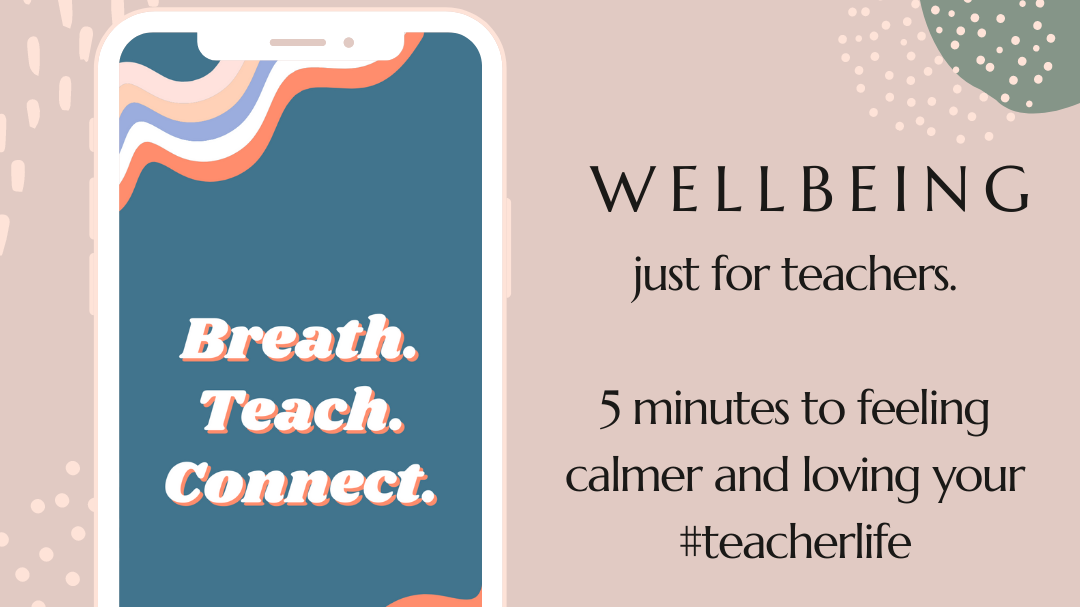
Banish Educator Burnout with the App Teach Breath Connect
By DR. RACHEL HALLQUIST
Overview
Almost half of new teachers leave the profession within the first 5 years. School leadership changes about every 3 years.
Hi, I’m Rachel. I’m a full-time mentor for teachers and I’ve worked in education for 20 years. I’ve seen how burnout impacts teachers’ abilities to do important work and stay in the profession. I’ve seen how it impacts students. This impact is magnified for students in schools with the highest needs, as these schools often have the highest rates of teacher turnover. I’ve mentored teachers in high-needs schools and have seen the impact burnout has on students’ educations. High turnover leads to staffing problems, especially in content areas like math and science, and again, concentrated more in high-needs urban and rural schools. Furthermore, teaching skills develop and improve over time and the teacher workforce fails to collectively benefit from this improvement when a large percentage of the workforce leaves the profession.
For years, I heard from school leaders that this is just how things are. There is even research on teacher burnout cycles and this research is bleak. In the current educational context with virtual learning, teachers have never been more isolated. As we reopen, let’s build better ways for teachers to connect and support each other.
We can do better for teachers and students and I have a solution, the Breathe Teach Connect app for teachers.
I developed and tested a journaling and meditation process that proved to support teacher wellbeing. I had a control group that did not use these practices and reported levels of wellbeing consistent with the research on new teacher burnout (teachers start the year happy and plummet into despair and disillusionment within a few months). However, the experimental group that used the journal and meditation for 3 months reported:
- An overall sense of happiness.
- Positive relationships with students and colleagues.
- Increased interest in their jobs.
- A sense of meaning and achievement in their teaching.
These teachers even reported these benefits 3 months after they stopped using journaling and meditation! The tools I developed are very easy, inexpensive, and can be completed in just a few minutes a week.
The journal is simple. Teachers write answer three simple questions:
1. What went well? This supports teachers in savoring the positive moments of their day and helps them to experience positive emotions around their practice.
2. Why did this happen? This question support reflection on WHY good things are happening. It helps teachers call attention to their internal and external resources that support their successes. Since burnout is the depletion of resources, this question seeks to remind teachers of the resources that support them (their skills, their positive relationships, their healthy habits, their mindset, etc.).
3. How does this benefit your students? This question was designed to bolster a sense of meaning and achievement.
The components of this journaling practice are strategic to support dimensions of wellbeing (positive emotions, meaning, and achievement).
My study suggests we CAN do something about teacher burnout and it’s not expensive or difficult. We CAN help teachers stay in the profession longer so they can continue to do the important work we need in education.
My solution is a simple but powerful app for teachers that incorporates:
1. The journaling technique I have tested.
2. Brief guided meditations for teachers.
3. Simple wellbeing assessments to support teachers monitoring their wellbeing.
4. Features that support making these wellbeing strategies habits such as notifications, challenges, and badges. These features can be adapted based on teacher needs and use and even on the results of their assessment. If they report they are struggling with relationships at work, the system could push out ideas and strategies to support that need. Teachers could also set wellness goals and track them.
5. Spaces to connect and collaborate with other teachers: Based on my research into what teachers need and how they like to connect virtually, the app would also feature:
- Channels: Teachers love to connect with other people in similar situations, teaching similar populations, similar topics, similar grade levels, etc. They ALSO like to collaborate with folks with diverse expertise that they can leverage to learn. The app could serve this need with channels focused on teachers’ topics (grade level, type of school, instructional philosophy, fitness, etc). These could be moderated to keep them engaging and supportive.
- Challenges: Simple wellness challenges that teachers can complete in teams so they can encourage and support each other.
Content Advisory Council: In order to ensure the app serves the needs of all teachers, a content advisory council will be formed to continuously iterate on the app. This curatorial council will represent teachers with diverse identities from diverse backgrounds and contexts.
*The gratitude study design described here was informed by the “what went well” protocol described in Dr. Martin Seligman’s book Flourish.
Expected Impact
I’ve tested the techniques and found them to be effective with the teachers in my study at supporting teacher wellbeing, including teacher’s sense of achievement at their work. Based on research about emotions at work, I hypothesize that teachers that are happier perform better and are more likely to stay in the profession. By reducing burnout, we increase the overall experience and capacity of the teacher workforce as a whole.
*The gratitude study design described here was informed by the “what went well” protocol described in Dr. Martin Seligman’s book Flourish.
Adopt & Adapt
I tested the techniques in a large K12 school district and the next step is to test them in other districts within an app.
I need support with building the app and testing it in a variety of communities. App development and testing can be completed within 9 months (3 months to build and 6 months to test and gather data). After initial testing, the app can be revised and scaled up to serve educators worldwide.